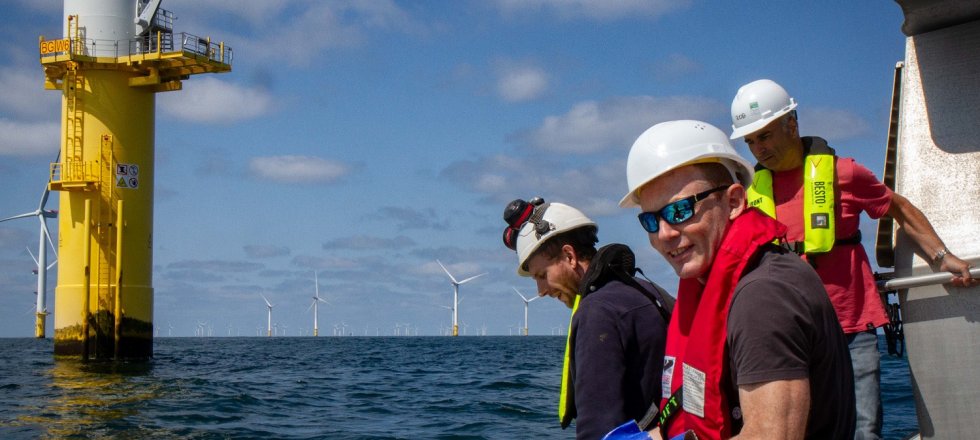Offshore wind in a healthy North Sea system
North Sea wind farms play a major role in the Dutch energy transition. By 2030, they should meet about 8.5 percent of the country’s total energy needs – almost five times as much as today. This calls for a considerable increase in windpower capacity. How can this be done in a sustainable way? How can we weigh the interests of the energy sector, fisheries and nature? Wageningen Marine Research (WMR) aims to help address these questions. Its researchers study the possible impacts of wind farms, as well as their potential for nature restoration and food production at sea.
Since 2016, the Dutch Ministry of Economic Affairs and Climate has financed a major research programme: the Offshore Wind Ecological Programme (Wozep). It is implemented by the Department of Public Works and Water Management. “Wageningen Marine Research is one of the parties that carry out sub-studies of Wozep”, says Josien Steenbergen, coordinator of WMR’s offshore wind research. “But our work in this area started long before that date, when the first Dutch offshore wind farms were constructed at the beginning of this century.”
What type of knowledge is needed for sound decision-making?
There are dozens of Wageningen projects in the area of offshore wind; some of those have already been completed. The research covers a broad spectrum, ranging from the effects of wind turbines on animals to the impacts of relocating fisheries, and from cumulative effects to options for nature restoration and offshore food production. “We often work together with other departments in Wageningen”, says Steenbergen, “such as Wageningen University, Wageningen Economic Research and Wageningen Plant Research. But also with Deltares, NIOZ, engineering firms such as Bureau Waardenburg, nature organisations and companies in the energy sector.”
Integrated approach
Research into the effects of offshore wind calls for an integrated approach, Steenbergen emphasises. “Deltares, for example, is investigating the effects of wind turbines on ocean currents and the production of phytoplankton. We use their results to study how potential changes may affect the food chain and what this could mean for the fisheries sector.”
Research is also focused on options for nature restoration, the cultivation of seaweed, crustaceans and shellfish, and passive fisheries. Steenbergen: “The next step is figuring out how these options are best approached. Which techniques are needed, how do you monitor progress, and what are the risks, both physically, ecologically and economically? These are all matters that call for an integrated approach. For this, we seek cooperation with offshore farmers, NGOs and the fisheries sector.”Knowledge-based decision-making
More and more interests are converging in the North Sea, concludes Steenbergen. An integrated approach is only possible with sufficient information about potential impacts. “Gathering this information is an important task for us”, says Steenbergen. “We also spend time contemplating questions such as: what type of knowledge is needed for sound decision-making? And how can you best gather this knowledge, and which partners should be involved?”
Wageningen Marine Research never dictates what others should do and where, emphasises the programme coordinator. “In the end, that is always a policy decision”, she says. “But we do our best, together with others, to provide the knowledge base for well-balanced, integrated decision-making.”
North Sea Agreement: framework for offshore wind
Offshore wind can play an important role in the energy transition of the Netherlands, as its government announced about two decades ago. Since then, ambitions and plans have been formulated at ever-increasing speed. In 2050, one sixth to one quarter of the Dutch North Sea surface will harbour offshore wind parks, according to official predictions.
“If you want this transition to be effective and sustainable, you need a certain degree of centralised coordination”, says Jakob Asjes, manager at Wageningen Marine Research. “Initially, separate environmental impact assessments and studies were conducted for each planned wind farm. But this led to fragmented conclusions. It became clear that there could be cumulative effects, and that an integrated approach was needed.”

We continuously strive to improve our scientific advice, and to provide clear answers to the knowledge questions, allowing for informed decision-making.
This idea lay at the core of the government programme Wozep (see main text). In parallel, the government developed a policy agreement, the North Sea Agreement, which also set the framework for offshore wind developments. “The agreement specifies that research and monitoring must be part of the decision-making process about developments in the North Sea”, says Asjes, “not just relating to the construction and operation of wind farms, but also in the area of nature and transitions in the food supply. Our research addresses these issues as well.”
More intensive cooperation

The North Sea Agreement contains specific provisions with regard to Monitoring, Research and Species Protection (MONS). On that basis, the Dutch government finances a large part of the required research. Various institutions are carrying it out, including Wageningen Marine Research. Asjes: “Work in this area makes up about a quarter of our portfolio – but this share is growing rapidly.”
Wageningen Marine Research is a major player in Dutch applied ecological research at sea. “But it is a small world, with much collaboration”, notes Asjes. “I expect that collaborations will strengthen as these developments continue – and that our approach will be increasingly integrated.”
Asjes not only refers to collaboration with fellow research organisations, but also with the Dutch government and relevant stakeholder organisations. Asjes: “We continuously strive to improve our scientific advice, and to provide clear answers to the knowledge questions, allowing for informed decision-making.”
For instance, if you relocate fisheries after area closures, how does this affect benthic sealife, fish stocks, and the fisheries sector itself? Asjes: “There are increasingly complex cascade effects and spatial planning issues. There are no ready-made policy scenarios or business cases yet, and things could play out in all directions. In this complex landscape, government and the various sectors have to collaborate closely with NGOs. We aim to contribute to the knowledge base that is required for all of this.”
